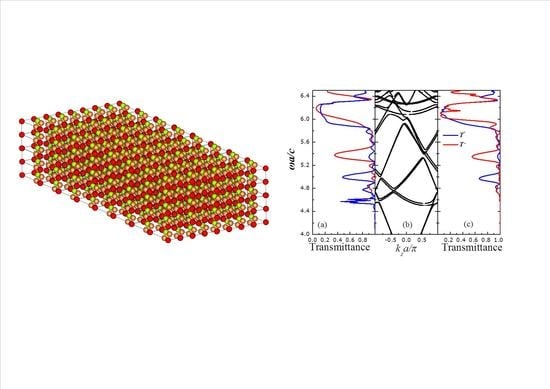Unidirectional Wave Propagation in Low-Symmetric Colloidal Photonic-Crystal Heterostructures
Abstract
:1. Introduction
2. Description of the Photonic-Crystal Heterostructure
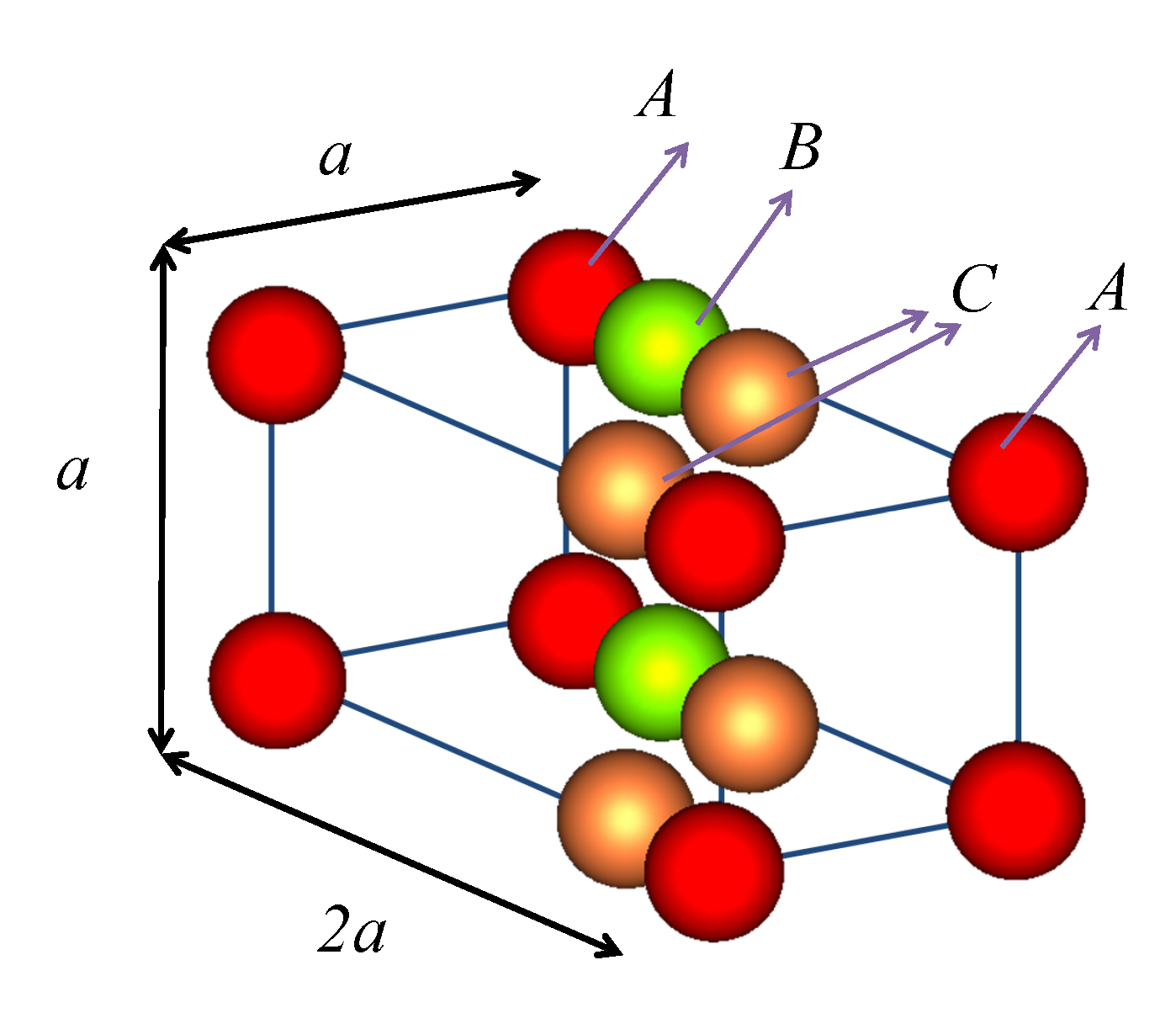
3. Calculation Method
4. Results and Discussion
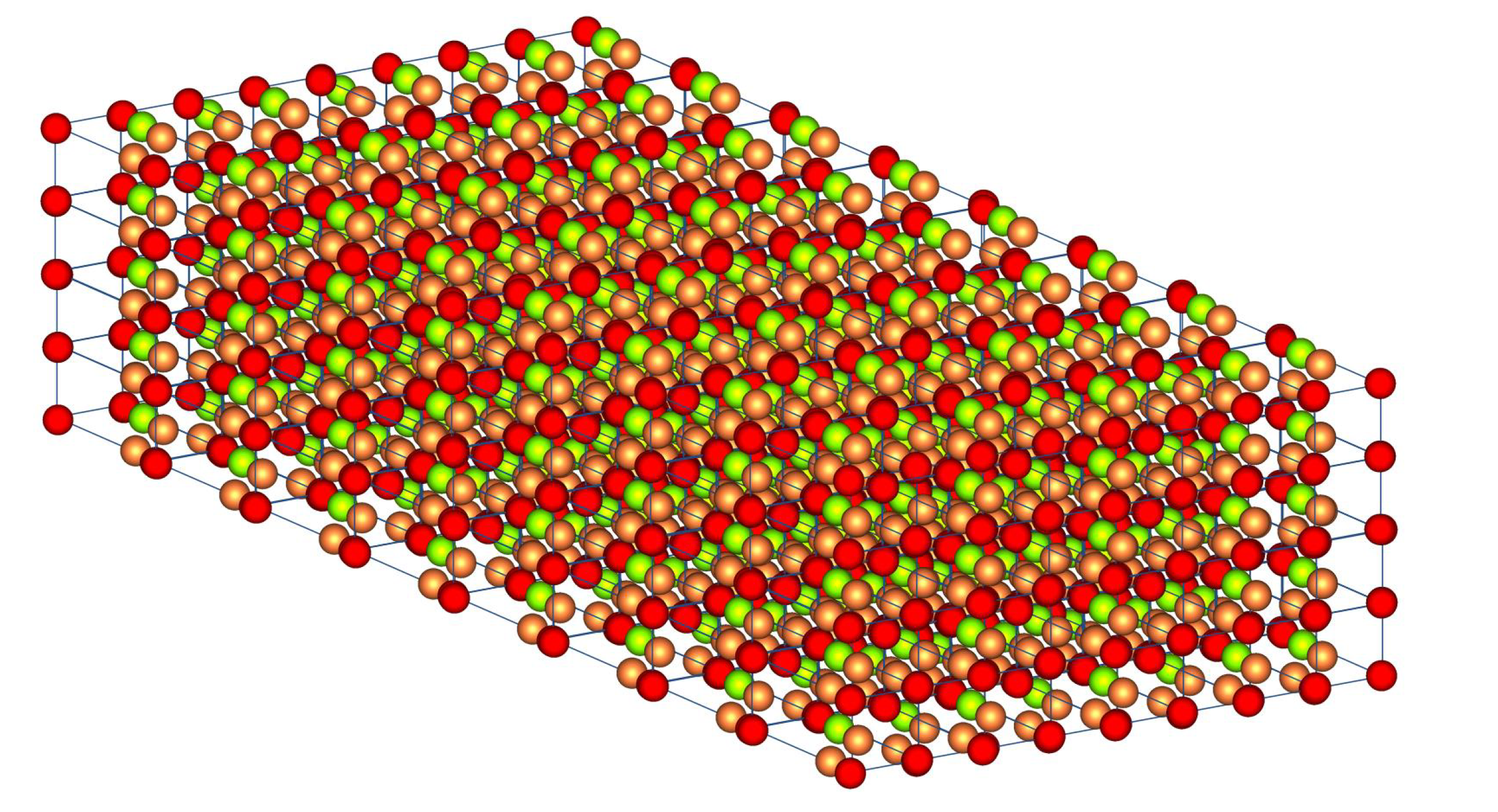
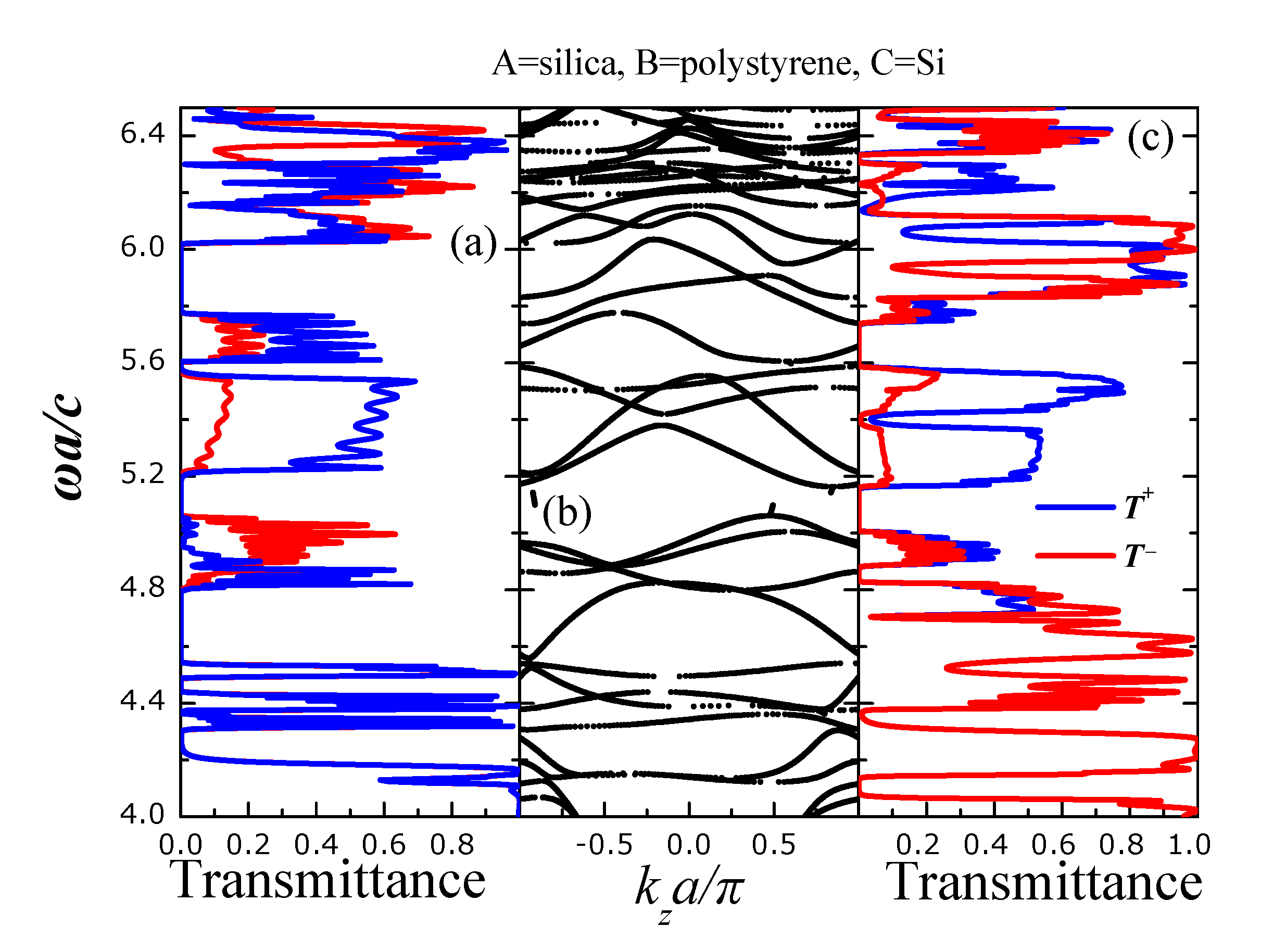
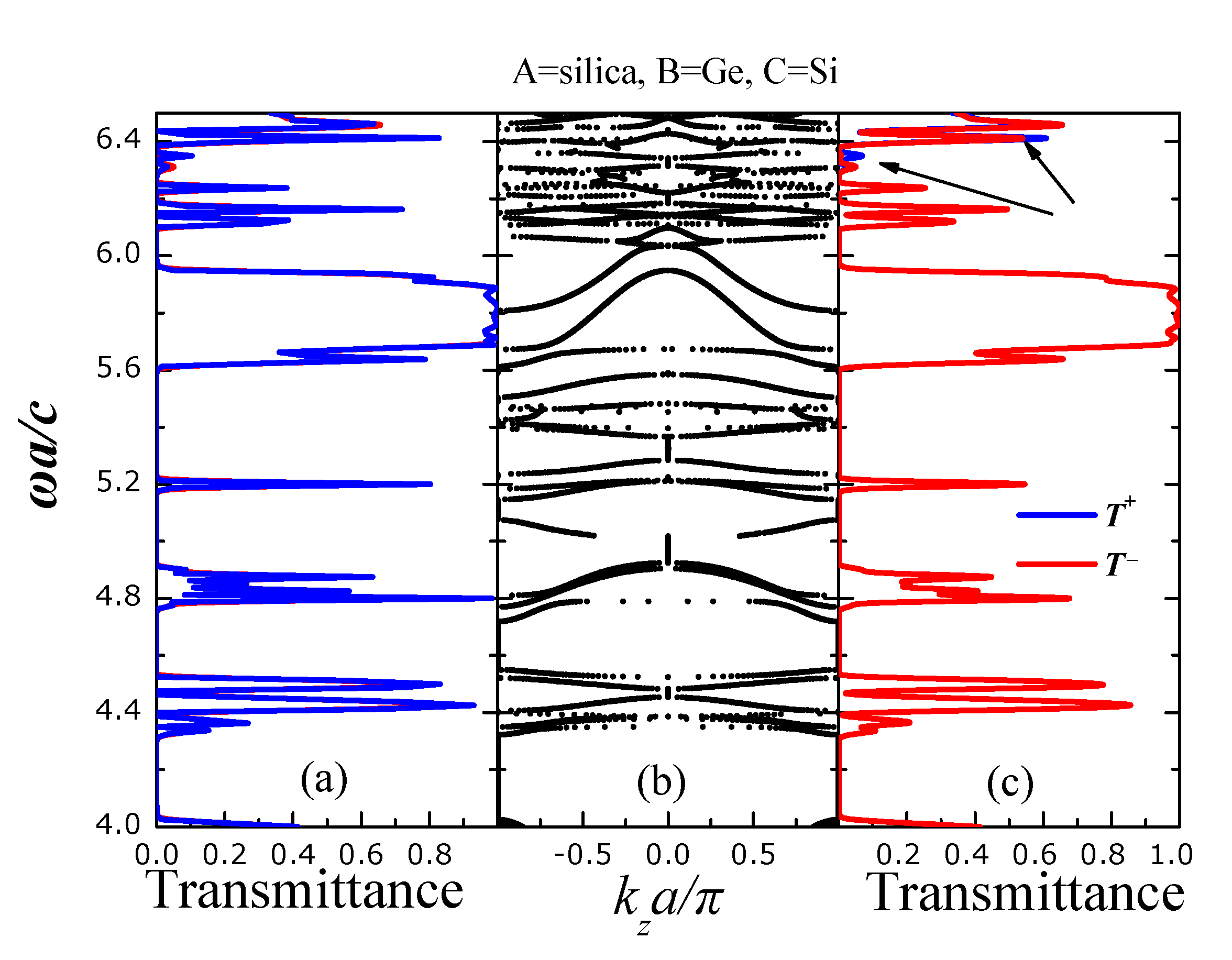
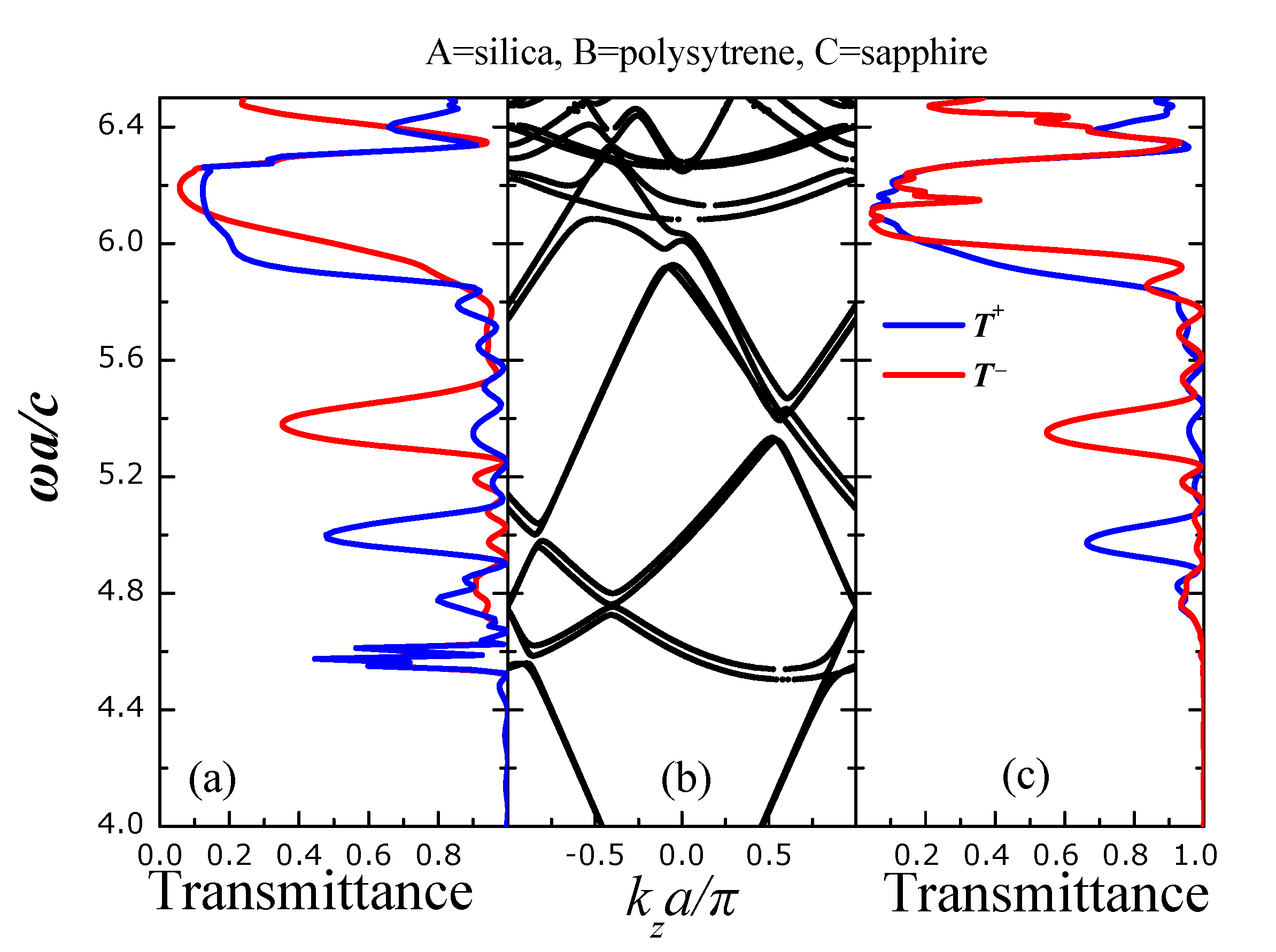
5. Conclusions
Conflicts of Interest
References
- Zolla, F.; Renversez, G.; Nicolet, A.; Kuhlmey, B.; Guenneau, S.; Felbacq, D. Foundations of Photonic Crystal Fibres; Imperial College Press: London, UK, 2005. [Google Scholar]
- Bozhevolnyi, S. Plasmonic Nanoguides and Circuits; Pan Stanford Publishing: Singapore, 2009. [Google Scholar]
- Haldane, F.D.M.; Raghu, S. Possible realization of directional optical waveguides in photonic crystals with broken time-reversal symmetry. Phys. Rev. Lett. 2008, 100, 013904. [Google Scholar] [CrossRef] [PubMed]
- Wang, Z.; Chong, Y.D.; Joannopoulos, J.D.; Soljacˇic´, M. Reflection-free one-way edge modes in a gyromagnetic photonic crystal. Phys. Rev. Lett. 2008, 100, 013905. [Google Scholar] [CrossRef] [PubMed]
- Wang, Z.; Chong, Y.D.; Joannopoulos, J.D.; Soljacˇic´, M. Observation of unidirectional backscattering-immune topological electromagnetic states. Nature 2009, 461, 772–775. [Google Scholar] [CrossRef] [PubMed]
- Yu, Z.; Veronis, G.; Wang, Z.; Fan, S. One-way electromagnetic waveguide formed at the interface between a plasmonic metal under a static magnetic field and a photonic crystal. Phys. Rev. Lett. 2008, 100, 023902. [Google Scholar] [CrossRef] [PubMed]
- Ao, X.; Lin, Z.; Chan, C.T. Dirac spectra and edge states in honeycomb plasmonic lattices. Phys. Rev. B 2009, 80, 033105. [Google Scholar] [CrossRef]
- Li, Y.; Zhang, Q.; Nurmikko, A.V.; Sun, S. Enhanced magnetooptical response in dumbbell-like Ag − CoFe2O4 nanoparticle pairs. Nano Lett. 2005, 5, 1689–1692. [Google Scholar] [CrossRef] [PubMed]
- González-Díaz, J.B.; García-Martín, A.; García-Martín, J.M.; Cebollada, A.; Armelles, G.; Sepúlveda, B.; Alaverdyan, Y.; Käll, M. Plasmonic Au/Co/Au nanosandwiches with enhanced magneto-optical activity. Small 2008, 4, 202–205. [Google Scholar] [CrossRef] [PubMed]
- Jain, P.K.; Xiao, Y.; Walsworth, R.; Cohen, A.E. Surface plasmon resonance enhanced magneto-optics (SuPREMO): Faraday rotation enhancement in gold-coated iron oxide nanocrystals. Nano Lett. 2009, 9, 1644–1650. [Google Scholar] [CrossRef] [PubMed]
- González-Díaz, J.B.; Sepúlveda, B.; García-Martín, A.; Armelles, G. Cobalt dependence of the magneto-optical response in magnetoplasmonic nanodisks. Appl. Phys. Lett. 2010, 97, 043114. [Google Scholar] [CrossRef]
- Dani, R.K.; Wanh, H.; Bossmann, S.H.; Wysin, G.; Chikan, V. Faraday rotation enhancement of gold coated Fe2O3 nanoparticles: Comparison of experiment and theory. J. Chem. Phys. 2011, 135, 224502. [Google Scholar] [CrossRef] [PubMed]
- Pakdel, S.; Miri, M. Faraday rotation and circular dichroism spectra of gold and silver nanoparticle aggregates. Phys. Rev. B 2012, 86, 235445. [Google Scholar] [CrossRef]
- Armelles, G.; Cebollada, A.; García-Martín, A. ; Gonzá M.U. Magnetoplasmonics: Combining magnetic and plasmonic functionalities. Adv. Opt. Mater. 2013, 1, 10–35. [Google Scholar] [CrossRef]
- Christofi, A.; Stefanou, N. Nonreciprocal optical response of helical periodic structures of plasma spheres in a static magnetic field. Phys. Rev. B. 2013, 87, 115125. [Google Scholar] [CrossRef]
- Christofi, A.; Stefanou, N. Nonreciprocal photonic surface states in periodic structures of magnetized plasma nanospheres. Phys. Rev. B. 2013, 88, 125133. [Google Scholar] [CrossRef]
- Nahal, A.; Talebi, R. Ellipticity-dependent laser-induced optical gyrotropy in AgCl thin films doped by silver nanoparticles. J. Nanopart. Res. 2014, 16. [Google Scholar] [CrossRef]
- Soljacˇic´, M.; Luo, C.; Joannopoulos, J.D.; Fan, S. Nonlinear photonic crystal microdevices for optical integration. Opt. Lett. 2003, 28, 637–639. [Google Scholar] [CrossRef] [PubMed]
- Scalora, M.; Dowling, J.P.; Bowden, C.M.; Bloemer, M.J. Optical limiting and switching of ultrashort pulses in nonlinear photonic band gap materials. Phys. Rev. Lett 1994, 73, 1368–1371. [Google Scholar] [CrossRef] [PubMed]
- Mingaleev, S.F.; Kivshar, Y.S. Nonlinear transmission and light localization in photonic-crystal waveguides. J. Opt. Soc. Am. B 2002, 19, 2241–2249. [Google Scholar] [CrossRef]
- Yu, Z.; Fan, S. Complete optical isolation created by indirect interband photonic transitions. Nat. Photon. 2009, 3, 91–94. [Google Scholar] [CrossRef]
- Hwang, J.; Song, M.H.; Park, B.; Nishimura, S.; Toyooka, T.; Wu, J.W.; Takanishi, Y.; Ishikawa, K.; Takezoe, H. Electro-tunable optical diode based on photonic bandgap liquid-crystal heterojunctions. Nat. Mater. 2005, 4, 383–387. [Google Scholar] [CrossRef] [PubMed]
- Lu, C.; Hu, X.; Zhang, Y.; Li, Z.; Xu, X.; Yang, H.; Gong, Q. Ultralow power all-optical diode in photonic crystal heterostructures with broken spatial inversion symmetry. Appl. Phys. Lett. 2011, 99, 051107. [Google Scholar] [CrossRef]
- Wang, C.; Zhou, C.Z.; Li, Z.Y. On-chip optical diode based on silicon photonic crystal heterojunctions. Opt. Express 2011, 19, 26948–26955. [Google Scholar] [CrossRef] [PubMed]
- Serebryannikov, A.E.; Nojima, S.; Ozbay, E. One-way absorption of terahertz waves in rod-type and multilayer structures containing polar dielectrics. Phys. Rev. B 2014, 90, 235126. [Google Scholar] [CrossRef]
- Lockyear, M.J.; Hibbins, A.P.; White, K.R.; Sambles, J.R. One-way diffraction grating. Phys. Rev. E 2006, 74, 056611. [Google Scholar] [CrossRef]
- Serebryannikov, A.E. One-way diffraction effects in photonic crystal gratings made of isotropic materials. Phys. Rev. B 2009, 80, 155117. [Google Scholar] [CrossRef]
- Kuzmiak, V.; Maradudin, A.A. Asymmetric transmission of surface plasmon polaritons. Phys. Rev. A 2012, 86, 043805. [Google Scholar]
- Yannopapas, V. One-way photonic band gaps and optical isolation with three-dimensional photonic crystals of low symmetry. Phys. Rev. A 2013, 88, 043837. [Google Scholar] [CrossRef]
- Stefanou, N.; Karathanos, V.; Modinos, A. Scattering of electromagnetic waves by periodic structures. J. Phys. Condens. Matter 1992, 4, 7389–7400. [Google Scholar] [CrossRef]
- Stefanou, N.; Yannopapas, V.; Modinos, A. Heterostructures of photonic crystals: Frequency bands and transmission coefficients. Comput. Phys. Commun. 1998, 113, 49–77. [Google Scholar] [CrossRef]
- Stefanou, N.; Yannopapas, V.; Modinos, A. MULTEM 2: A new version of the program for transmission and band-structure calculations of photonic crystals. Comput. Phys. Commun. 2000, 132, 189–196. [Google Scholar] [CrossRef]
- Gantzounis, G.; Stefanou, N.; Papanikolaou, N. Optical properties of periodic structures of metallic nanodisks. Phys. Rev. B 2008, 77, 035101. [Google Scholar] [CrossRef]
- Yannopapas, V.; Vanakaras, A.G. Layer-multiple-scattering theory for metamaterials made from clusters of nanoparticles. Phys. Rev. B 2011, 84, 085119. [Google Scholar] [CrossRef]
- Yannopapas, V. Layer-multiple-scattering method for photonic structures of general scatterers based on a discrete-dipole approximation/T-matrix point-matching method. J. Opt. Soc. Am. B 2014, 31, 631–636. [Google Scholar] [CrossRef]
- Kim, S.H.; Lee, S.Y.; Yang, S.M.; Yi, G.R. Self-assembled colloidal structures for photonics. NPG Asia Mater. 2011, 3, 25–33. [Google Scholar] [CrossRef]
- Ishii, M.; Kato, H.; Hashimoto, I.; Homma, Y. Synthesis of sapphire nanoparticles with graphite shells by hot-filament chemical vapor deposition. Mater. Express 2014, 4, 135–143. [Google Scholar] [CrossRef]
- Istrate, E.; Sargent, E.H. Photonic crystal heterostructures and interfaces. Rev. Mod. Phys. 2006, 78, 455–481. [Google Scholar] [CrossRef]
- Kedia, S.; Reddy, M.S.; Vijaya, R. Photonic crystal based direct and inverse heterostructures by colloidal self-assembly. Opt. Photon. J. 2012, 2, 242–248. [Google Scholar] [CrossRef]
- Cai, Z.; Liu, Y.J.; Teng, J.; Lu, X. Fabrication of large domain crack-free colloidal crystal heterostructures with superposition bandgaps using hydrophobic polystyrene spheres. ACS Appl. Mater. Interface 2012, 4, 5562–5569. [Google Scholar] [CrossRef]
- Liu, X.; Zhao, D.; Geng, C.; Zhang, L.; Tan, T.; Hu, M.; Yan, Q. Fabrication of colloidal photonic crystal heterostructures free of interface imperfection based on solvent vapor annealing. J. Colloid Interface Sci. 2014, 434, 98–103. [Google Scholar] [CrossRef] [PubMed]
© 2015 by the authors; licensee MDPI, Basel, Switzerland. This article is an open access article distributed under the terms and conditions of the Creative Commons Attribution license (http://creativecommons.org/licenses/by/4.0/).
Share and Cite
Yannopapas, V. Unidirectional Wave Propagation in Low-Symmetric Colloidal Photonic-Crystal Heterostructures. Nanomaterials 2015, 5, 376-385. https://doi.org/10.3390/nano5010376
Yannopapas V. Unidirectional Wave Propagation in Low-Symmetric Colloidal Photonic-Crystal Heterostructures. Nanomaterials. 2015; 5(1):376-385. https://doi.org/10.3390/nano5010376
Chicago/Turabian StyleYannopapas, Vassilios. 2015. "Unidirectional Wave Propagation in Low-Symmetric Colloidal Photonic-Crystal Heterostructures" Nanomaterials 5, no. 1: 376-385. https://doi.org/10.3390/nano5010376
APA StyleYannopapas, V. (2015). Unidirectional Wave Propagation in Low-Symmetric Colloidal Photonic-Crystal Heterostructures. Nanomaterials, 5(1), 376-385. https://doi.org/10.3390/nano5010376




